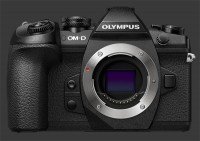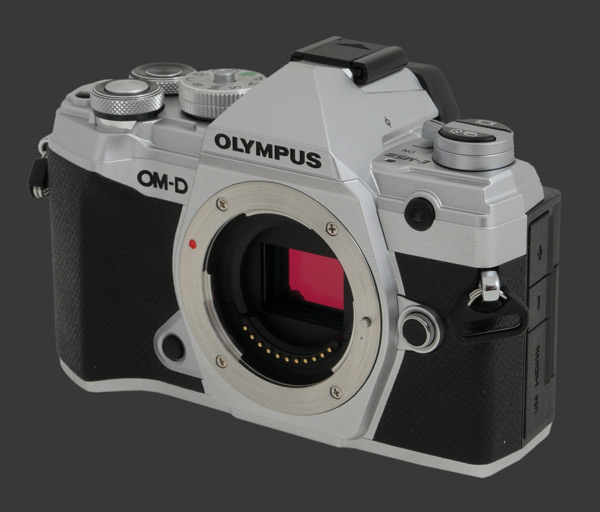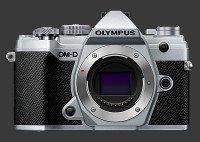Olympus OM-D E-M5 Mark III Review
Olympus OM-D E-M5 Mark III Performance - How well does it take pictures?
Performance starts with image quality, which is the criteria used as the foundation of our digital camera ratings. Ergonomic issues may get in the way, but in the end, image quality counts the most. For an ILC, image quality greatly depends on the lens used. While color, noise, exposure and dynamic-range are properties of a camera, distortion, vignetting and chromatic aberrations are properties of the lens. Sharpness and contrast depend on the weakest link. That is, a camera cannot capture more details than a lens lets through. Conversely, it is quite possible for a lens to transmit more details than a sensor can capture.

Image Noise & Details
The Olympus OM-D E-M5 Mark III delivers good image quality. It compared well to its predecessor with more aggressive noise reduction applied. This results in lower image-noise at higher sensitivities but also fewer fine details. The results are mostly equivalent and even slightly better at maximum ISO. The new processor though renders Super Resolution mode much better though and produces an image that really extracts 50 MP of details from the subject.
Image noise is extremely low until ISO 1600 and barely there at 3200 where it remains usable for relatively large prints. For most common print sizes, all these settings are completely usable and make a good range for Auto ISO. Contrast and color are very consistent in the ISO 200-3200 range, although expanded ISO 64 shows slightly lower dynamic-range.
There is substantial softness due to noise-reduction at ISO 6400. Details get lost which limited prints to medium-size at best. Noise remains low though which makes such image scale down well. At this level, dynamic-range takes a noticeable dip while colors remain quite nice.
ISO 12800 brings a significant loss of details to smooth out most noise along with them. This truly restricts the usability of the sensitivity to the smallest print sizes. The maximum sensitivity of ISO 25600 makes things both noisy and very soft, leaving it usable only for small emergency prints.
There are three levels of noise-reduction available. NR can also be turned off entirely. Off results in better detail in mid-level ISO but shows noise quite early. Unfortunately the low setting now is not so gentle. Anything higher obliterates details quite rapidly. Default sharpness is well calibrated on the E-M5 Mark III. Higher levels immediately show oversharpening artifacts.
Super-Resolution is extremely impressive. It gathers full color information at each pixels plus an outstanding about of details. The output is comparable to at least a 40 MP camera throughout its available ISO 64-1600 range. Resulting images show surprisingly little noise and offer improved dynamic-range.

Color & White Balance
The OM-D E-M5 Mark III struggles with color accuracy. There are lots of Picture Modes but none produce realistic colors across the spectrum. The most realistic colors are obtained in Muted style with Saturation and Contrast dialed up to +1. The red channel remains too high regardless of settings. Similar yet more punchy results can be achieved starting with Natural color mode and dialing down from there. This is obviously not applicable when shooting RAW, although it does affect the preview.
Generally, the Automatic White-Balance system of the Olympus OM-D E-M5 Mark III performs less well than expected. In broad daylight, colors are neutral most of the time. Indoors though, there is often a slight yellow cast, even with the option to correct for warm colors enabled. Without it enabled, the issue can be even more pronounced. In low-light, AWD really struggled and starts producing yellow-tinged images. Luckily, WB is previewed by the EVF which makes it easy to notice and correct the issue. Still, this performance is disappointing considering that the Mark II consistently gave good results..
Exposure
Metering with the Multi-Segment Metering system of this digital camera is very good. It rarely misses exposure by much and produces well-balanced images. There are two notable situations where overexposure is more frequent. One is when faced with backlit scenes. The other is in the presence of small bright highlights. In either case, expect about -1 EV compensation to be required. Low contrast scenes are exposed towards the mid-tone which makes them look natural.
It is important to know that the LCD clips extreme highlights which may still be correctly captured. This happens when adjusting the highlight tone-curve too. Differences are barely noticeable on the LCD but images are in fact captured differently. Changes to the shadow tone-curve are much easier to see. When in doubt, the Playback histogram must be checked. The Live-Histogram is only truly accurate in M mode.

Auto Focus
One significant change from its predecessor is the new 121-Point Phase-Detect AF system of the Mark III. These points cover most of the frame and are assisted by Contrast-Detection. The on-sensor elements that record phase data makes autofocus much more decisive than before. It seems that there is some imprecision in the system which makes it often rely to Contrast-Detect to nail focus. This improves speed but leaved undesirable wobble when AF is used during video capture.
Autofocus is fast and quite reliable. When there is plenty of light, the E-M5 Mark III can lock focus in 1/4s, which is similar to mid-range DSLRs. Low light causes the system to slow down somehow which may require 1/2s to achieve focus but rarely more. All points are made equal and so the camera focuses just as easily and precisely with any of them. Although focus is correctly locked in most cases, our sample camera missed focus on a few occasion, mostly near bright light sources yet not as frequently as the Olympus OM-D E-M1 Mark II
Olympus OM-D E-M1 Mark II.
With typical Micro Four-Thirds lenses, focus is done via a fly-by-wire ring around the lens-barrel. The E-M5 Mark III keeps up really well with no perceptible lag. In DMF mode, a slight turn of the focus-ring shift into manual focus. Because the ring is fly-by-wire, the E-M5 Mark III can reverse the direction of rotation to adjust focus. This does not apply to the handful of Micro Four-Thirds lenses with a mechanical focus-rings.

Speed
Modern mirrorless digital cameras like the E-M5 Mark III are highly-responsive. There is an immediate response when any dial is turned, button is pressed or the Eye-Start Sensor is triggered. Dramatic changes in exposure take a fraction of a second to take effect while the camera adjusts its sensor amplification. Motion is shown fluidly on both the EVF and LCD.
A hybrid shutter allows the E-M5 Mark III to take fully advantage of the output of its high-speed CMOS sensor. Using its electronic-shutter mode, called Silent Shutter by Olympus since it makes no sound at all, this camera can capture full-resolution images at 30 FPS which can be sustained for 26 JPEG images or 23 RAW files. Continuous drive from 5 to 30 FPS are supported. The mechanical shutter is usable until 10 FPS. At that speed, the E-M5 Mark III store an unlimited number of JPEG images or 150 RAW files, both impressive numbers.
Multi-image processing is exceptionally quick. HDR images are produced in under 2 seconds after capturing 4 frames to blend. Super-Resolution requires a few extra seconds to render its output but is much quicker than before. Enabling optional image processing has virtually no impact on performance.
The Olympus OM-D E-M5 Mark III rarely holds back the photographer. The following measurements characterize its performance:
- Power-On: 1 second. Average.
- Power-On to First-Shot: 1½s. Good.
- Autofocus: ¼s in good to moderate light. About ½s in low light. Good.
- Shutter-lag: Instant with virtually no blackout. Excellent.
- Shot-to-Shot Speed: Just over ½s. Great.
- Playback: Almost instant to enter or exit. Excellent.
- Power-Off: Nearly instant second. Very good.
- Video: ½s to start, instant to stop. A little slow.
The Mark II already showed a very solid performance but the new Mark III improves in many areas. The shutter lag and blackout are much better now, while shot-to-shot and autofocus speed both incrementally got faster. There is still a tiny delay when starting to record video but it is better. Continuous drive modes show much more steady and long lasting bursts, while the EVF and LCD manage to keep up really well with action.
The Olympus OM-D E-M5 Mark III is powered by a proprietary Lithium-Ion battery which provides 310-shots per charge. This is the metric that puts the Mark III behind its predecessor, most likely due to its more powerful processor. This goes down very quickly and so at least 2 extra batteries are recommended for a typical day of photography. For action photography, at least twice that is needed since it does not take long to capture that many images at 30 FPS.
Olympus OM-D E-M5 Mark III Conclusion

The OM-D series started with the original E-M5 bringing professional features to the Micro Four-Thirds platform. It introduced the first builtin EVF and weatherproof body in the lineup. When the Mark II launched, viewfinder magnification improved and the body become freezeproof. The latest Olympus OM-D E-M5 Mark III takes things to the next level with a 20 MP High-Speed CMOS sensor capable of 30 FPS continuous shooting and Cinema 4K video capture, while keeping an exceptionally compact design and making it even more efficient.
Olympus delivered a truly capable digital camera with the E-M5 Mark III. Image quality is really good for a Four-Thirds sensor and comes surprisingly close to APS-C. Noise stays very low until ISO 3200 with help from more aggressive noise-reduction. Although minor, this is a noticeable improvement from its predecessor while also increasing resolution slightly. The new Super-Resolution mode is significantly improved though and captures details much closer to a camera with a native 50 MP resolution.
Dynamic-range is particularly good for this sensor-size and the Olympus Multi-Segment metering-system produces well-balanced exposures under most conditions. The highly adjustable tone-curve of this camera is a fantastic tool to maximize captured detail. Colors are close to reality yet never perfect. There is a tendency to shift towards red from Picture Styles and Automatic Balance leans towards under artificial lighting. Both these issues are easy to correct by computer.
The most significant upgrade for the third-generation E-M5 is its speed. 30 FPS are possible using an electronic-shutter while the mechanical one can handle 10 FPS for long periods. This speed makes multi-image features incredibly fast, including Super-Resolution mode, builtin HDR and Live Composite. The camera remains very responsive at all times and its new 121-Point Phase-Detect AF system is measurably quicker. The new AF system is very flexible, reliable and consistent.
A few simplifications of features and handling have made the Olympus E-M5 Mark III much more efficient than previous models. This camera is bursting with features and is able to tackle any type of photography. A handful of changes are steps backwards from the Mark II but overall the result is a more streamlined experience. Built quality remains outstanding with a full weatherproof and freezeproof body that can withstand the elements.
At this point, there are a number of highly capable mirrorless on the market and this one is ready to challenge them. Where the Olympus OM-D E-M5 Mark III truly succeeds is in bringing so many professional features in a compact form with efficient handling. Compared to its predecessor, the Mark III incrementally improved in numerous areas, most notably speed and video quality.
 |
Please Support Neocamera
All information on Neocamera is provided free of charge yet running this website is a huge endeavor. Purchases made via affiliate links found throughout the site help keep it running and up-to-date. There is no additional cost to you, so please consider buying via these links to our affilates:
If you found any information on this site valuable and did not purchase via our affiliate links, please considering donating via PayPal:
Any amount will be greatly appreaciated. Thank you for your support!
Olympus E-M5 Mark III Highlights

Sensor-Size: 17 x 13mm

Actual size when viewed at 100 DPI
| 20 Megapixels Mirrorless | ISO 64-25600 |
| Micro Four-Thirds Mount 2X FLM | Shutter 1/32000-60s |
| 5-Axis Built-in Stabilization, 5.5-Stop Improvement | Full manual controls, including Manual Focus |
| 0.39" Built-in EVF 2.4 Megapixels (0.68X) | Custom white-balance with 2 axis fine-tuning |
| Automatic Eye-Start sensor | Spot-Metering |
| 2 Axis Digital Level | Hot-Shoe |
| Weatherproof down to -10C | Stereo audio input |
| Built-in Dust Reduction | Lithium-Ion Battery |
| 30 FPS Drive, 26 Images | Secure Digital Extended Capacity |
| 4096x2160 @ 24 FPS Video Recording | |
| 3" LCD 1 Megapixels |
Updates
2025.01.18

Fujifilm GFX 2025 Lens Roundup
Lens Review roundup of Fujifilm GFX Medium-Format lenses. Quality, performance and handling of the GF20-35mm F/4R WR, GF30mm F/3.5 Tilt-Shift and the GF55mm F/1.7.
2024.11.18

Best 2024 Photography Gifts for Every Budget
Great gifts for photographers and photo enthusiasts selected for every budget among the best products of 2024.
2024.08.07

Eye Protection Tips for Professional Photographers
The four main considerations for professional photographers regarding eyewear.
2024.07.14

Fujifilm X100VI Review
Flagship fixed-lens compact digital camera with a 40 MP sensor and Image-Stabilization, a first for the series. Retro design featuring dual control-dials, plus direct ISO, Shutter-Speed and EC dials. Its hybrid viewfinder can switch between EVF and OVF mode.
2024.05.09

Fujifilm GFX100 II Review
Flagship 102 Megapixels Medium-Format Mirrorless Digital Camera with 8-Stop 5-Axis IBIS, 8 FPS Drive, 8K Video and 400 MP Super-Resolution capture in a weatherproof and freezeproof body with dual control-dials and dual memory-card slots.
2024.04.03

Fujifilm X-T5 Review
Newest Fujifilm flagship boasting a 40 MP APS-C sensor, 5-axis IBIS with 7-stop efficiency, 15 FPS continuous drive, 6.2K Video capture, dual control-dials and dual SDXC UHS-II slots in a sturdy weatherproof and freezeproof body.
2023.11.20

Best Digital Cameras of 2023
Find out which are the Best Digital Cameras of 2023. All the new Mirrorless Digital Cameras from entry-level to high-end professional.
2023.07.10

Fujifilm X-H2 Review
40 Megapixels APS-C Hybrid Mirrorless Digital Camera with 7-stop IBIS. Fastest shutter ever and 8K video capture. Large builtin EVF with 0.8X magnification and 5.8 MP, plus an Eye-Start Sensor. Packed with features and large number of controls in a weatherproof and freezeproof body.
2023.05.07

Sony FE 20-70mm F/4G Review
Review of the unique Sony FE 20-70mm F/4G lens. The optical zoom of this lens spans ultra-wide-angle and medium focal-length coverage, making it one of the most versatile Full-Frame lenses on the market.
2023.01.15

Huion Inspiroy Dial 2 Review
Review of the Huion Inspiroy Dial 2 tablet, a medium sized drawing surface with dual dials and customizable buttons. Connects via USB-C or Bluetooth 5.0 with Windows, Linux and Android support.
2022.12.08

How to Pack for a Photo Trip
Find out how to pack for a travel photography trip, carry your gear safely while meeting airline regulations.
2022.11.13

Best Digital Cameras of 2022
The best digital cameras of 2022. A short list of the most outstanding models in their respective categories. Choose one for yourself or as a gift.












